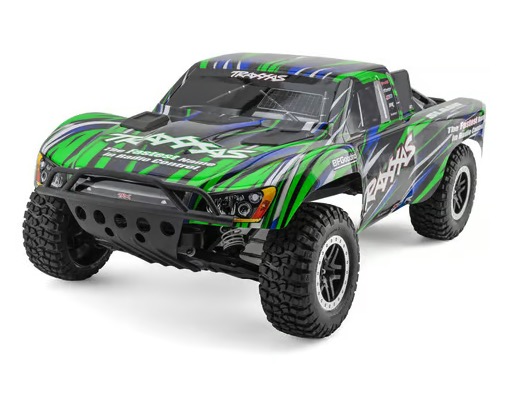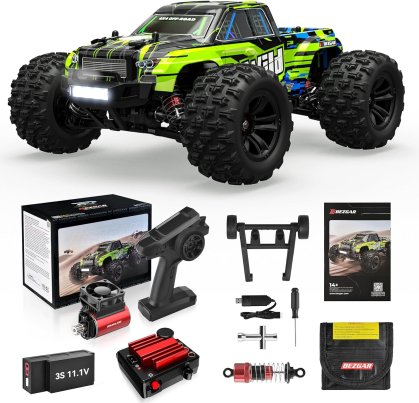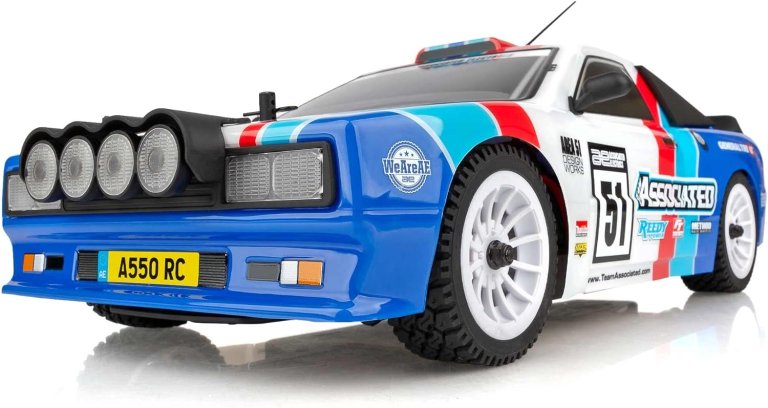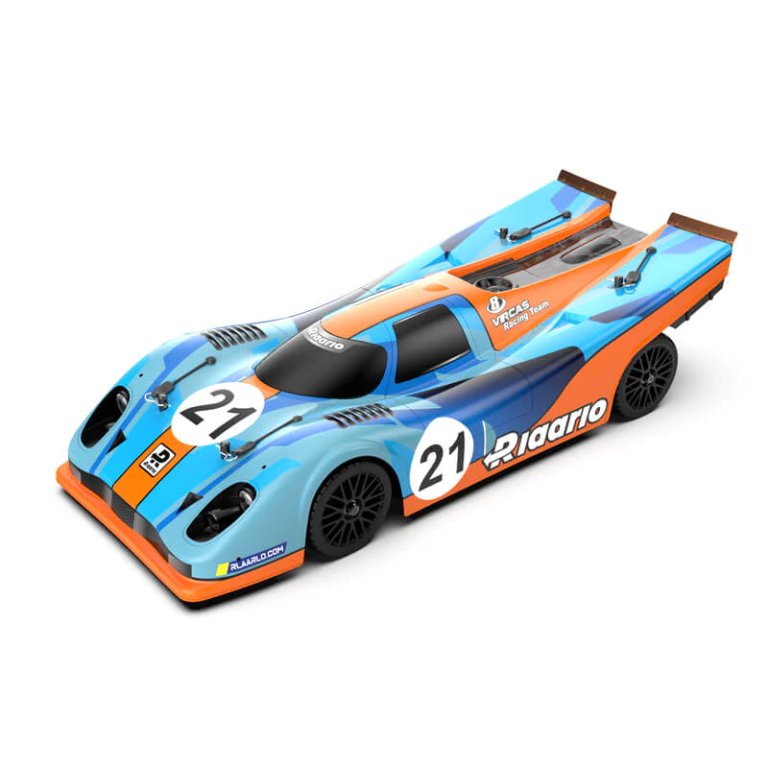We may earn revenue from the products available on this page and participate in affiliate programs. Learn more ›
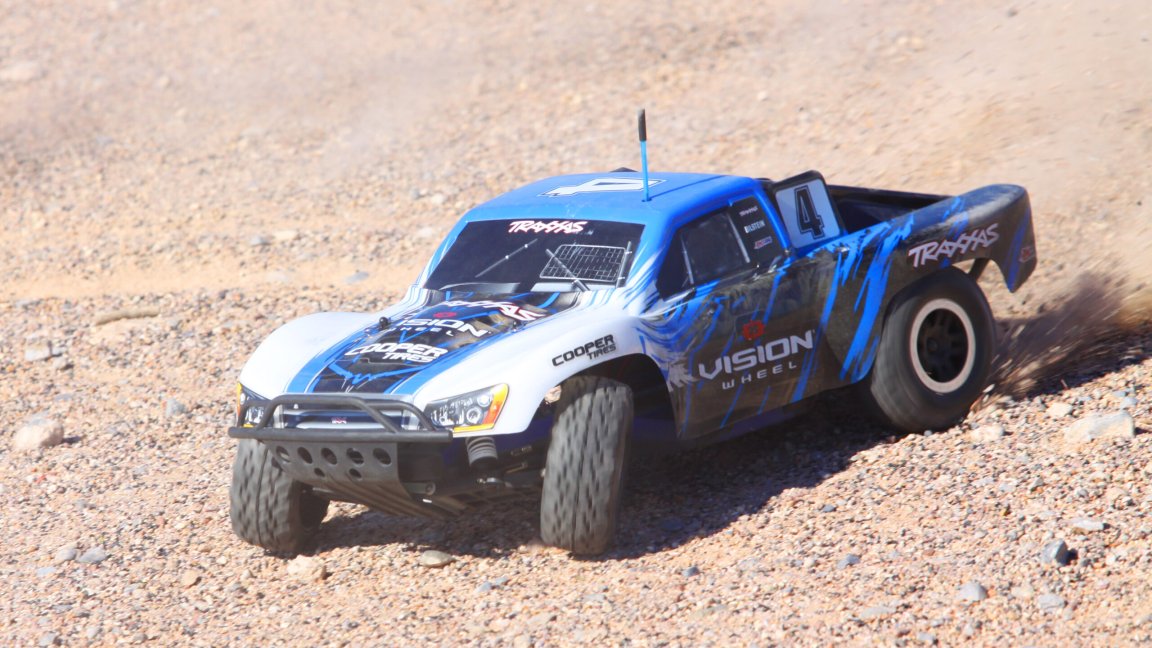
RC cars are the gateway that got many of us to where we are today. Hobby-level cars have all the same systems as real cars. Turning wrenches on one of these, either as a kid or adult, scratches the itch while requiring far less space and budget than the real thing. The same can be said for driving and competitive racing of RC cars.
If you’re brand new to the hobby, or like me have taken long breaks in order to focus on life stuff, I can help guide the way. The market is stacked with options, making it hard to determine which is best for you. My top pick is the Traxxas Slash, but it’s far from the only good choice. As you can see below, there are a few more I think highly of. Don’t worry, though. I’ll talk you through how I came to that conclusion with this buying guide. Today, we’re talking about the best RC cars in general, but be sure to check out our roundups of RC drift cars and RC trucks for more recommendations.
Summary List
- Best Overall: Traxxas Slash
- Best Value: BEZGAR HP161S 1:16 4WD Brushless
- Best Nostalgic: Team Associated RC10DS Classic
- Best On-Road Car: Tamiya Formula E Gen 2 TC-01
- Best for Drifting: Team Associated Apex2 Sport A550 Rally Car RTR
- Best Beginner High-Speed Car: AMORIL AK-917 Brushless 75mph RTR Supercar
Our Methodology
You may be wondering what qualifies me to speak as an expert on RC cars or to write toy car reviews in general. The answer is a combination of testing, years of experience, and research. Some manufacturers sent us products for testing, and I even own a few cars that may or may not have made the list. My Laegendary Thunder RC truck review and Laegendary Grando RC rock crawler review are great examples to check out.
As I looked around, I kept value and fun at the top of my list, considering many of you are parents looking for a great gift to share with your kids. That said, ruggedness, reliability, and versatility were all weighed as well. Parts availability is another real concern. Not just because you may need to repair your RC car but also because modifying it is a big part of the journey. Of course, user reviews and customer service experiences were all read into as well to ensure we’re only recommending RC cars that are worthwhile. To read more about our process and standards, click here.


Best RC Cars: Reviews & Recommendations
Best Overall: Traxxas Slash 2WD BL-2S RTR
Pros
- Great performance right out of the box
- Repair and upgrade parts are available at most hobby shops
- Spec classes are the most affordable and approachable way to get into racing
Cons
- While this will jump and do donuts, it is not the best basher
Specs:
- Scale: 1:10
- Speed: 35+ mph
- Recommended Age: 14+
I’ve owned a Traxxas Slash for a little over two years. OK, it’s actually my son’s Slash, but I’ve driven it quite a bit and helped him with most of the wrenching for both repairs and the few modifications that have been done. I chose this truck for him for the same reasons it’s my Best Overall Pick. Out of the box, the truck has plenty of performance and flies off sweet jumps, does big drifts, and looks like a trophy truck at speed. It has good suspension travel, and the stock oil-filled shocks and springs are matched well and on the soft side, so there’s lots of body roll and squat.
As my son has gotten better at driving, upgrades have been easy and relatively affordable to do. So far, nothing on the truck has broken – no one is more shocked than me. The battery charger that comes in the kit is adequate at best, so that will be the first thing you want to upgrade. Buying a selection of springs and shock oil is a cheap way to start learning handling dynamics. The exaggerated body roll will quickly go away, but the truck gets a lot faster.
The radio included with the kit is still great, it works in both my large hands and his. It has been disassembled and reassembled several times without issue, none of the plastic parts have stripped and everything lines back up just like the factory. This truck comes in a variety of styles from this 2WD BL-2S Brushless version to 4WD and a 3S brushless versions of both. There is also a kit version available that might be the best choice for long-time enthusiasts.
Best Value: BEZGAR HP161S 1:16 4WD Brushless
Pros
- The value is literally unbelievable for people who have been in the hobby for years
- Brushless, full ball bearings, metal drivetrain, it’s a tough little truck
- It’s fast, does wheelies, will fly off jumps and do all the bashing
Cons
- Great basher but not for people who may want to race
- Parts are only available online through Amazon or Bezgar’s site
- At this point, there doesn’t seem to be an aftermarket for service parts or modifications
Specs:
- Scale: 1:16
- Speed: 25 mph
- Recommended Age: 8+


If what you’re looking for is big jumps, wheelies, and bashing on a budget, this is your best option. Like everything else in the world, YouTube videos and social media have given people expectations of extreme action in everything they do. This 1/16th scale brushless truck delivers the extreme with power to spare, literally. If you give this thing full throttle from a stop, it will wheelie so fast it literally flips on its top. There is a beginner throttle mode which basically limits you to part throttle. It is a little too tame and there is no inbetween. But, you quickly learn respect for the amount of power delivered by the brushless motor and LiPo battery. And it includes a wheelie bar.
Everything you need comes in the box. The tires are so huge compared to the size of the body it looks like a slammed monster truck, but that’s a good thing. Everything on the truck is tough, even after several bashing sessions, I have yet to break anything. The all metal drivetrain and thick plastic parts are to thank for that. If and when it does finally break, most of the suspension parts and bulkheads which are most likely to snap first, are available on Amazon.
The included controller is smaller than those you find included in hobby shop RTR (Ready To Run) cars, but halfway through the first run it feels natural in your hand. The battery pack looks like it would be proprietary, but it has a Dean’s type connector. I will need to figure out how to make the battery strap fit a different style pack, but that doesn’t seem like much of a challenge. For the price of this Bezgar, nothing comes close to the performance. I will admit to being suspicious about a “non-hobby shop” brand when I started out, but the seas are changing quickly. I don’t know what cars like this will mean for the industry in the long run, but good cars at lower prices aren’t a bad thing for consumers.
Best Nostalgic: Team Associated RC10DS Classic
Pros
- Team Associated is legendary for quality and this kit is a prime example
- Great scale looks and performance
- Building this kit will teach you more about machines than 6 months of YouTube University
Cons
- The kit only includes the car. Electronics, radio, battery, and charger will double the price
- This is a passion purchase and is only going to be competitive with other vintage cars
Specs:
- Scale: 1:10
- Speed: As Fast As You Want
- Recommended Age: 14+
Long time hobbyists will love the nostalgia of this car. First, it looks like Tommy Kendal’s winning Trans Am car, but underneath that body is a car based on the original RC10. It has shorter shock towers, different front suspension geometry and the aluminum chassis is black instead of gold, but it’s basically an on-road version of the buggy we grew up racing.
This is an unassembled kit. You get to build it; how awesome is that? It also requires you to supply electrics and electronics. You could build this up with a period-correct Reedy, brushed motor with a 6-cell NiMH pack or go full nuts and burn the tires off at half-throttle with a 3S brushless set-up.
It comes with modernized versions of the traditional gold shocks and anti-roll bars. The steering uses the bell-crank system, basically the same as it was on the original RC10 40 years ago. The transmission, however, is the Stealth version with the internal differential from the 90s. This isn’t a cheap kit, especially by the time you buy everything to make it run, but who can put a price on middle-aged car enthusiasts trying to recapture their youth?
Best On-Road: Tamiya Formula E Gen 2 TC-01
Pros
- An electric rc race car may as well be based on a real electric race car
- The TC-01 is a very good, if underappreciated platform capable of spec racing or touring car classes
- Chassis is capable stock, but can be built up to extremely high levels of performance
Cons
- Requires radio, electronics, battery and charger to complete
- does not include a full set of bearings, which is frustrating at the price
Specs:
- Scale: 1:10
- Speed: 50+ mph
- Recommended Age: 16+
The Tamiya TC-01 chassis is one of the most underrated and largely ignored platforms on the market. It’s a shaft-driven all-wheel drive platform with inboard shocks, sealed differentials, and an exceptionally-mid-mounted motor. Yes, there are a lot of mid-motor cars out there, but Tamiya went all-in on keeping everything centralized. The layout gives the car an extremely low polar moment of inertia, meaning it rotates and changes directions quickly. Although it’s only been sold as the Formula E car you see here, it’s easily converted for touring car racing and a YouTuber has even built one into a rally car.
The toughness of the car leads to enthusiasts’ most common complaint, it’s heavier than some of its competitors. If you’re going racing in open classes, you may not have the selection of lightweight parts that drivers of other touring cars have at their disposal. This car’s handling, ease of driving, and durability might make up for that.
This is another kit. You will need to supply a radio, and electronics including a motor, battery, and charger, and while you are at it, you will want to pick up a ball bearing kit. Like all Tamiya kits, if you aren’t all that familiar with how cars work, you will be after some time with this kit. As mentioned, this has been used as a rally car by changing out several parts, but I would probably keep this for on-road use only.
Best Beginner Rally Car: Team Associated Apex2 Sport A550 Rally Car RTR
Pros
- This rally car includes everything you need in one box
- Good performance with more than enough power to start rallying
- Looks great, simple and tough design handles abuse, upgradeable when you’re ready
Cons
- The price could warrant a brushless system but does include a LiPo battery
Specs:
- Scale: 1:10
- Speed: NA
- Recommended Age: 14+
Who doesn’t love rallying? The answer is people who’ve never seen it, those are the only people who don’t love rallying. RC rallying is no different. Although there is a huge variety of rally cars out there, this is one of the best. Team Associated turned buggy racing on its head with the introduction of the original RC10 in 1984. Today, the company still builds some of the fastest and most technologically advanced racing buggies in the industry. This Rally car isn’t the fastest or most high-tech, but the Associated dedication to quality is on full display.
The Apex 2 Sport platform is built on a plastic tub that houses the shaft-driven all-wheel-drive system and rides on dual control arm suspension which uses friction shocks. The friction shocks are as disappointing as the fact that it doesn’t include ball bearings. I’m not as disappointed as some critics with the brushed 550 motor. If you’re familiar with rallying, you know it isn’t about huge power – real WRC cars have a hybrid power system that makes a nominal 380hp with bursts of 500hp possible. This car does include a 2S LiPo battery but can also run on 3S for even more power.
The kit includes a pretty decent XP120 radio which has all the functionality you need as a beginner. But, even those of us who have been around the hobby for a while will enjoy throwing this around in the dirt or even on the road. Sure, you will probably want to start upgrading this car after a few months, but you can say the same thing about Team Associated buggies that are twice the price for a rolling chassis. I love the Lancia Beta Monte Carlo-esque body and the big chunky tires. It’s worth noting that the Traxxas Fiesta is also a compelling package, but doesn’t have the same scale feel.
Best Beginner High-Speed Car: AMORIL AK-917 Brushless 75mph RTR Supercar
Pros
- It looks a lot like a Porsche 917
- A lot of high-end parts and performance for a modest price
- It is really fast but can be upgraded to basically ground-based missile speeds
Cons
- Durable enough for a regular RC car but crashing at 75 MPH will break anything
- You can’t run down to your local hobby shop to buy parts
Specs:
- Scale: 1:10
- Speed: 75 mph
- Recommended Age: Adult
The advent of relatively affordable and undeniably small GPS-based speed, and G-force data loggers has opened up the hobby to speed running anywhere you have the space. The Rlaarlo AK-917 from Amoril will have you running at insane speeds right out of the box. There are a few different versions of this car available from Amazon or directly from the company. You can get basic rollers with no electronics. Then there are competing cars that range from brushed-powered (up to 50MPH), to brushless 3S cars(up to 80MPH), and Brushless 4S cars the company claims will do over 120MPH with the right gearing.
I recommend the mid-level brushless cars which include a chassis, shocks, motor mount, and driveshaft all made from aluminum. The universal shafts and differentials are steel and it has a full bearing kit. It also includes a 2S LiPo battery, a 4-channel controller and a charger you’ll probably want to replace. While this is sold almost entirely on it’s top speed, it does handle well. You aren’t going to take this racing with dedicated touring cars, but if you set up a parking lot road course, you’ll enjoy it.
The downside of this car is that it is another online-only car. You can’t get parts at your local hobby shop. If the parts are available on Amazon, you can probably have them in a couple of days. If you have to go directly to the manufacturer, it might be a couple of weeks. Amoril does offer a number of aluminum parts for this car to make it more durable; they are pretty reasonably priced too. This is a fun car. It has the performance to keep you interested but like most cars, it’s the looks that get you first.



What to Consider When Buying An RC Car
With so much to choose from when buying an RC car, paralysis by analysis is a real struggle. Consider what your goals are with the car. Do you just want to have fun driving, go for huge air or do you strive to be a competitive RC racer for on or off-road? What’s your budget? What’s your skill level? What else should you consider when picking the best RC car to suit your needs?
Key Features
Batteries
Like all other electronic devices, lithium batteries are quickly becoming the standard, although nickel-metal is still the most affordable choice. Lithium offers higher voltage and higher capacity in smaller, lighter packaging. They do require more care and cost a little more money. The initial investment is more, but in the long run, you will probably get more value out of lithium batteries.
Motor
As lithium batteries are taking over, so are brushless motors. Brushed is still the choice for lower-priced cars, although online-only brands are making the shift to brushless happen quicker. A brushless motor has more power and can handle higher voltage. They are also considered maintenance-free. Right now, the initial investment for a brushless car over brushed at the hobby shop level is considerable, so it isn’t always an option for beginners.
Pricing
Pricing on RC cars can vary quite a bit. Performance level, build quality, the features included, and more can all directly impact what you pay for a given model. Entry-level units can last anywhere from $50-$200. Intermediate-level models can exist anywhere from $500, and professional-level models can sit around $1,000 or more.
Our Verdict
The Traxxas Slash is so versatile and offers so much performance that it’s hard to think of anything that could be a better overall choice. For those who are specifically looking for a basher to take to skateparks and BMX tracks, the Bezgar Brushless truck can’t be touched for the price.
FAQs
You’ve got questions. The Drive has answers!
A: Yes, anything that isn’t a disposable toy will require a battery pack for operation. Many RC bundles will include a battery pack, but you will need to look on the list of requirements to see if you will need to buy one separately. If you need to buy a battery, you will most almost certainly need to buy a charger as well.
A: The most common scale is 1/10th, although larger and smaller offerings are becoming more popular. Smaller cars, like 1/16 or 1/18 are becoming popular as bashers, crawlers or drifters, anything much smaller will pretty much be indoor only. Bigger models, 1/6 and larger, require much more space and become ridiculously expensive, quickly matching the price of dirt bikes and UTVs.
A: “RTR” means that your RC car is ready to run. It’s ready to drive right out of the box with no assembly required. It usually includes the controller, batteries, and charger. Other RC cars come as kits that have to be assembled prior to use.
A. RC cars can be cleaned with compressed air and soft brushes with appropriate cleaners. If the electronics are waterproof, a low-pressure water hose may also be used.
A. You may be able to upgrade your RC car with a new, faster motor. Some models can also be set up with different gears and tires to improve acceleration. It all depends on the specifics of the RC car you’re working with.
